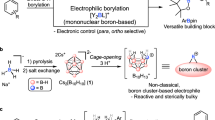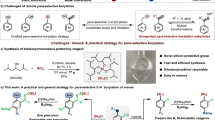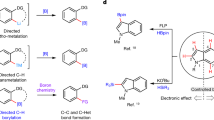Abstract
Suzuki-type cross-coupling is one of the most common strategies for the construction of C–C bonds. Despite great progress on the preparation of C(sp2)–C(sp2) bonds, C(sp2)–C(sp3) cross-coupling with aliphatic halides remains rare, especially with tertiary aliphatic halides and under transition-metal-free conditions. Here we report an efficient C(sp2)–C(sp3) cross-coupling between α-(pseudo)halo aliphatic ketones and arylboronic acids via a 1,4-metallate shift. The α-arylated ketones obtained from this protocol under transition-metal-free and additive-free conditions in the presence of base are formed when the key intermediate enolate traps the arylboronic acid, leading to a tetracoordinate boron intermediate. A subsequent 1,4-metallate shift affords the Suzuki-type coupling products. This strategy provides a practical, scalable and operationally straightforward method for the synthesis of C(sp2)–C(sp3) bonds, and is compatible with challenging tertiary aliphatic halides, allowing for the preparation of 1,3-disubstituted target products.

This is a preview of subscription content, access via your institution
Access options
Subscribe to this journal
Receive 12 digital issues and online access to articles
$119.00 per year
only $9.92 per issue
Buy this article
- Purchase on Springer Link
- Instant access to full article PDF
Prices may be subject to local taxes which are calculated during checkout




Similar content being viewed by others
Data availability
The data that support the findings of this study are available within the article and its Supplementary Information files. The X-ray crystallographic coordinates for structures reported in this article have been deposited at the Cambridge Crystallographic Data Centre (CCDC), under deposition number 2085418 (3a). The data can be obtained free of charge from the CCDC via http://www.ccdc.cam.ac.uk/datarequest/cif.
References
Miyaura, N. & Suzuki, A. Palladium-catalyzed cross-coupling reactions of organoboron compounds. Chem. Rev. 95, 2457–2483 (1995).
Suzuki, A. Cross-coupling reactions of organoboranes: an easy way to construct C–C bonds (Nobel Lecture). Angew. Chem. Int. Ed. 50, 6722–6737 (2011).
Deng, Q., Zheng, Q., Zuo, B. & Tu, T. Robust NHC-palladacycles-catalyzed Suzuki–Miyaura cross-coupling of amides via C–N activation. Green Synth. Catal. 1, 75–78 (2020).
Huang, W., Han, M.-L., Liu, Y.-W., Xu, H. & Dai, H.-X. Palladium-catalyzed diarylative dearomatization of indoles with aryl thioesters. Chin. Chem. Lett. 32, 2765–2768 (2021).
Jana, R., Pathak, T. P. & Sigman, M. S. Advances in transition metal (Pd,Ni,Fe)-catalyzed cross-coupling reactions using alkyl-organometallics as reaction partners. Chem. Rev. 111, 1417–1492 (2011).
Swift, E. C. & Jarvo, E. R. Asymmetric transition metal-catalyzed cross-coupling reactions for the construction of tertiary stereocenters. Tetrahedron. 69, 5799–5817 (2013).
Li, C., Chen, T., Li, B., Xiao, G. & Tang, W. Efficient synthesis of sterically hindered arenes bearing acyclic secondary alkyl groups by Suzuki–Miyaura cross-couplings. Angew. Chem. Int. Ed. 54, 3792–3796 (2015).
Li, C. et al. Sterically demanding aryl–alkyl Suzuki–Miyaura coupling. Org. Chem. Front. 1, 225–229 (2014).
McCarty, B. J. & Tang, W. A dancing nickel in asymmetric catalysis: enantioselective synthesis of boronic esters by 1,1-addition to terminal alkenes. Green Synth. Catal. 2, 1–3 (2021).
Wu, L., Yang, G. & Zhang, W. Ni-catalyzed enantioconvergent coupling of epoxides with alkenylboronic acids: construction of oxindoles bearing quaternary carbons. CCS Chem. 2, 623–631 (2020).
Tian, J., Li, W., Li, R., He, L. & Lv, H. Nickel-catalyzed asymmetric arylative cyclization of N-alkynones: efficient access to 1,2,3,6-tetrahydropyridines with a tertiary alcohol. Chin. Chem. Lett. 32, 4038–4040 (2021).
Yao, L. et al. Visible-light-induced chemoselective reactions of quinoxalin-2(1H)-ones with alkylboronic acids under air/N2 atmosphere. Chin. Chem. Lett. 32, 4033–4037 (2021).
Li, C. et al. Transition-metal-free stereospecific cross-coupling with alkenylboronic acids as nucleophiles. J. Am. Chem. Soc. 138, 10774–10777 (2016).
Frisch, A. C. & Beller, M. Catalysts for cross-coupling reactions with non-activated alkyl halides. Angew. Chem. Int. Ed. 44, 674–688 (2015).
Kambe, N., Iwasaki, T. & Terao, J. Pd-catalyzed cross-coupling reactions of alkyl halides. Chem. Soc. Rev. 40, 4937–4947 (2011).
Tasker, S. Z., Standley, E. A. & Jamison, T. F. Recent advances in homogeneous nickel catalysis. Nature 509, 299–309 (2014).
Sang, R., Noble, A. & Aggarwal, V. K. Chiral benzothiophene synthesis via enantiospecific coupling of benzothiophene S-oxides with boronic esters. Angew. Chem., Int. Ed. 60, 25313–25317 (2021).
Hari, D. P., Madhavachary, R., Fasano, V., Haire, J. & Aggarwal, V. K. Highly diastereoselective strain-increase allylborations: rapid access to alkylidenecyclopropanes and alkylidenecyclobutanes. J. Am. Chem. Soc. 143, 7462–7470 (2021).
Bennett, S. H. et al. Difunctionalization of C–C σ-bonds enabled by the reaction of bicyclo[1.1.0]butyl boronate complexes with electrophiles: reaction development, scope, and stereochemical origins. J. Am. Chem. Soc. 142, 16766–16775 (2020).
Mega, R. S., Duong, V. K., Noble, A. & Aggarwal, V. K. Decarboxylative conjunctive cross-coupling of vinyl boronic esters using metallaphotoredox catalysis. Angew. Chem. Int. Ed. 59, 4375–4379 (2020).
Stymiest, J. L., Bagutski, V., French, R. M. & Aggarwal, V. K. Enantiodivergent conversion of chiral secondary alcohols into tertiary alcohols. Nature 456, 778–782 (2008).
Zhang, L. et al. Catalytic conjunctive cross-coupling enabled by metal-induced metallate rearrangement. Science 351, 70–74 (2016).
Xiao, Q. et al. Transition-metal-free electrophilic amination of arylboroxines. Org. Lett. 14, 4230–4233 (2012).
Wu, G., Deng, Y., Wu, C., Zhang, Y. & Wang, J. Synthesis of α-aryl esters and nitriles: deaminative coupling of α-aminoesters and α-aminoacetonitriles with arylboronic acids. Angew. Chem. Int. Ed. 53, 10510–10514 (2014).
Li, H. et al. Formal carbon insertion of N-tosylhydrazone into B–B and B–Si bonds: gem-diborylation and gem-silylborylation of sp3 carbon. Org. Lett. 16, 448–451 (2014).
Petasis, N. A. & Akritopoulou, I. The boronic acid Mannich reaction: a new method for the synthesis of geometrically pure allylamines. Tetrahedron Lett. 34, 583–586 (1993).
Jiang, Y. & Schaus, S. E. Asymmetric petasis borono-Mannich allylation reactions catalyzed by chiral biphenols. Angew. Chem. Int. Ed. 56, 1544–1548 (2017).
Hu, Y. et al. Stereoselective synthesis of trisubstituted vinylboronates from ketone enolates triggered by 1,3-metalate rearrangement of lithium enolates. Angew. Chem. Int. Ed. 58, 15813–15818 (2019).
Roscales, S. & Csáky, A. G. Synthesis of ketones by C–H functionalization of aldehydes with boronic acids under transition-metal-free conditions. Angew. Chem. Int. Ed. 60, 8728–8732 (2021).
Petasis, N. A. & Zavialov, I. A. A new and practical synthesis of α-amino acids from alkenyl boronic acids. J. Am. Chem. Soc. 119, 445–446 (1997).
Tian, D. et al. Stereospecific nucleophilic substitution with arylboronic acids as nucleophiles in the presence of a CONH group. Angew. Chem. Int. Ed. 57, 7176–7180 (2018).
Ming, W. et al. Concise synthesis of α-amino cyclic boronates via multicomponent coupling of salicylaldehydes, amines, and B2(OH)4. Green Chem. 22, 2184–2190 (2020).
Hirano, K. et al. Nucleophilic diboration strategy targeting diversified 1-boraphenarene architectures. Angew. Chem. Int. Ed. 59, 21448–21453 (2020).
Mai, S., Li, W., Li, X., Zhao, Y. & Song, Q. Palladium-catalyzed Suzuki–Miyaura coupling of thioureas or thioamides. Nat. Commun. 10, 5709–5721 (2019).
Yang, K. et al. Construction of axially chiral arylborons via atroposelective Miyaura borylation. J. Am. Chem. Soc. 143, 10048–10053 (2021).
Wang, S., Xu, J. & Song, Q. Modular synthesis of polysubstituted quinolin-3-amines by oxidative cyclization of 2-(2-isocyanophenyl)acetonitriles with organoboron reagents. Org. Lett. 23, 6789–6794 (2021).
Zhang, F. et al. An olefinic 1,2-α-boryl migration enables 1,2-bis(boronic esters) via radical-polar crossover reaction. Chin. J. Chem. 40, 582–588 (2022).
Zhu, S., Yan, J. & Song, Q. Pyridinium-catalyzed decarboxylative borylation of benzoyl peroxides. Green Synth. Catal. 2, 299–302 (2021).
Yang, K. et al. Passerini-type reaction of boronic acids enables α-hydroxyketones synthesis. Nat. Commun. 12, 441–450 (2021).
Yang, K., Zhang, F., Fang, T., Zhang, G. & Song, Q. Stereospecific 1,4-metallate shift enables stereoconvergent synthesis of ketoximes. Angew. Chem. Int. Ed. 58, 13421–13426 (2019).
Xu, H., Ye, M., Yang, K. & Song, Q. Regioselective cross-coupling of isatogens with boronic acids to construct 2,2-disubstituted indolin-3-one derivatives. Org. Lett. 23, 7776–7780 (2021).
Li, C. et al. Photo-induced trifunctionalization of bromostyrenes via remote radical migration reactions of tetracoordinate boron species. Nat. Commun. 13, 1784–1795 (2022).
Yang, K. et al. Transition-metal-free double-insertive coupling of isocyanides with arylboronic acids enabled diarylmethanamines. Cell Rep. Phys. Sci. 1, 100268–100243 (2020).
Ma, X., Su, J. & Song, Q. Unconventional transformations of difluorocarbene with amines and ethers. Acc. Chem. Res. https://doi.org/10.1021/acs.accounts.2c00830 (2023).
Li, H., Hughes, R. P. & Wu, J. Dearomative indole (3 + 2) cycloaddition reactions. J. Am. Chem. Soc. 136, 6288–6296 (2014).
He, Z., Song, F., Sun, H. & Huang, Y. Transition-metal-free Suzuki-type cross-coupling reaction of benzyl halides and boronic acids via 1,2-metallate shift. J. Am. Chem. Soc. 140, 2693–2699 (2018).
Tao, L. et al. Rhodium-catalyzed deoxygenation and borylation of ketones: a combined experimental and theoretical investigation. J. Am. Chem. Soc. 142, 18118–18127 (2020).
Zheng, S.-C., Wang, Q. & Zhu, J. Catalytic kinetic resolution by enantioselective aromatization: conversion of racemic intermediates of the Barton–Zard reaction into enantioenriched 3-arylpyrroles. Angew. Chem. Int. Ed. 58, 9215–9219 (2019).
Frisch, M. J. et al. Gaussian 09, Revision D.01 (Gaussian, 2013).
Becke, A. D. Density-functional thermochemistry. III. The role of exact exchange. J. Chem. Phys. 98, 5648–5652 (1993).
Lee, C., Yang, W. & Parr, R. G. Development of the Colle–Salvetti correlation-energy formula into a functional of the electron density. Phys. Rev. B 37, 785–789 (1988).
Zhao, Y. & Truhlar, D. G. The M06 suite of density functionals for main group thermochemistry, thermochemical kinetics, noncovalent interactions, excited states, and transition elements: two new functionals and systematic testing of four M06-class functionals and 12 other functionals. Theor. Chem. Acc. 120, 215–241 (2008).
Cossi, M., Barone, V., Cammi, R. & Tomasi, J. Ab initio study of solvated molecules: a new implementation of the polarizable continuum model. Chem. Phys. Lett. 255, 327–335 (1996).
Acknowledgements
Financial support from National Natural Science Foundation of China (21931013 and 22271105), the Natural Science Foundation of Fujian Province (2022J02009), the Open Research Fund of School of Chemistry and Chemical Engineering, Henan Normal University and numerical computations at the Hefei advanced computing centre is gratefully acknowledged. Dedicated to Professor Zhenfeng Xi on the occasion of his 60th birthday.
Author information
Authors and Affiliations
Contributions
Q.S. designed and directed the project. X.L. performed the experiments and developed the reactions. Q.Z., H.W. and H.S. helped collecting some of the experimental data. X.L. prepared the Supplementary Information. Y.L. directed the DFT calculations, H.C. performed DFT calculations and drafted the DFT sections. Q.S. and X.L. wrote the paper. All authors discussed the results and commented on the paper.
Corresponding authors
Ethics declarations
Competing interests
The authors declare no competing interests.
Peer review
Peer review information
Nature Synthesis thanks the anonymous reviewers for their contribution to the peer review of this work. Primary Handling Editor: Peter Seavill, in collaboration with the Nature Synthesis team.
Additional information
Publisher’s note Springer Nature remains neutral with regard to jurisdictional claims in published maps and institutional affiliations.
Supplementary information
Supplementary Information
Experimental details, Supplementary Figs. 1–184 and Tables 1 and 2.
Supplementary Data 1
Crystallographic data for compound 3a, CCDC 2085418.
Rights and permissions
Springer Nature or its licensor (e.g. a society or other partner) holds exclusive rights to this article under a publishing agreement with the author(s) or other rightsholder(s); author self-archiving of the accepted manuscript version of this article is solely governed by the terms of such publishing agreement and applicable law.
About this article
Cite this article
Li, X., Chen, H., Wang, H. et al. Transition-metal-free C(sp2)–C(sp3) cross-coupling of α-(pseudo)halo aliphatic ketones with boronic acids via a 1,4-metallate shift. Nat. Synth 2, 1211–1221 (2023). https://doi.org/10.1038/s44160-023-00373-9
Received:
Accepted:
Published:
Issue Date:
DOI: https://doi.org/10.1038/s44160-023-00373-9



